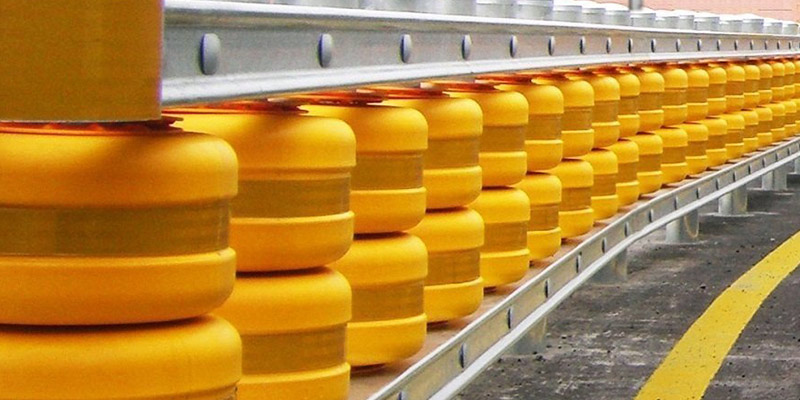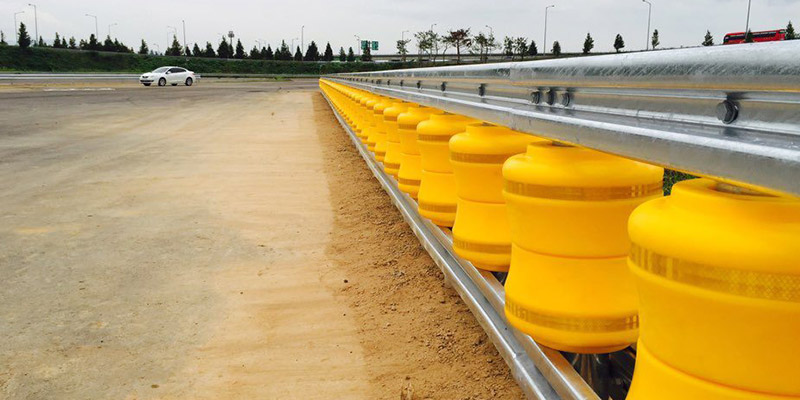A drum barrier system is a special type of road safety barrier consisting of horizontal drums mounted on a support structure. Its primary purpose is to reduce the impact force on vehicles and occupants in the event of a collision between a vehicle and the barrier.
It consists of rotatable drums (typically made of high-strength plastic or metal), support columns, and connecting components. The drums can freely rotate upon impact, a key feature enabling their functionality.
When a collision occurs, the rotating drums disperse and absorb the impact energy, significantly reducing the force transmitted to the vehicle and its occupants, thereby lowering the risk of injury. This energy-absorbing mechanism effectively mitigates the severity of injuries caused by collisions.
The rolling action of the drums guides the vehicle along the direction of the guardrail, preventing it from suddenly rebounding onto the road surface or rolling over due to a severe impact. This helps maintain traffic order at the accident site and reduces the likelihood of secondary accidents.
In areas near pedestrians or cyclists, the system's energy absorption performance reduces the risk of secondary injuries to vulnerable road users caused by vehicles deviating after a collision, providing an additional layer of safety protection for them.

Whether on highways, mountain roads, urban expressways, or bridge sections, the roller guardrail system can be effective, particularly in high-risk areas such as curves or steep slopes.
The drum guardrail system is made from weather-resistant materials, capable of withstanding extreme temperatures, rain and snow, and corrosion, maintaining stable performance under various climatic conditions.
It can be installed alongside other traffic facilities (such as standard guardrails, rumble strips, etc.) without disrupting the normal operation of the existing road system, making it convenient for upgrades and renovations on existing roads.
The modular design allows for easy replacement of damaged rollers or components, reducing the time and costs associated with maintenance and repairs. There is no need for large-scale inspections of the entire barrier system, significantly improving maintenance efficiency.
By minimising vehicle damage and occupant injuries, the roller barrier system reduces economic losses caused by accidents, including vehicle repair costs and medical expenses for personnel.
High-quality materials and rational structural design ensure that the drum guardrail system has a long service life, reducing the frequency and cost of overall replacement, making it more economical in the long run.
Pre-fabricated components enable efficient on-site installation, minimising disruption to traffic during construction and ensuring smooth road traffic flow.
The rollers are painted in vibrant colours (such as yellow or orange) to enhance visibility. Especially in low-light conditions, they alert drivers to maintain a safe distance from the guardrail and prepare for evasion in advance.
The streamlined design allows the system to blend seamlessly with the road environment, avoiding the oppressive feel of traditional rigid guardrails. It ensures safety while also considering road aesthetics.

Compared to rigid concrete or metal barriers, the drum barrier system better disperses collision energy through the rotation of the drums rather than resisting collisions rigidly, providing better protection for vehicles and personnel.
Traditional barriers, which rely on rigid contact, often result in severe vehicle damage; the rotating function of the drum system provides cushioning, reducing the extent of vehicle deformation.
Traditional barriers, once damaged, often require large-scale replacement of components; the drum barrier system only needs to replace individual drums or components, saving time and labour costs.
It enhances overall road safety, reduces accident handling costs, improves maintenance efficiency, and alleviates management pressure.
In the event of an accident, the roller barrier system provides higher safety protection, increases occupant survival rates, and reduces the severity of injuries.
It helps reduce losses caused by traffic accidents, maintain smooth traffic flow, and promote the development of road safety culture, holding significant social significance.
The roller barrier system offers significant advantages in terms of safety protection, adaptability, cost-effectiveness, and practical application. As an advanced road safety facility, it plays a crucial role in mitigating accident injuries and ensuring road traffic safety, making it an ideal choice for modern road construction and safety enhancement.